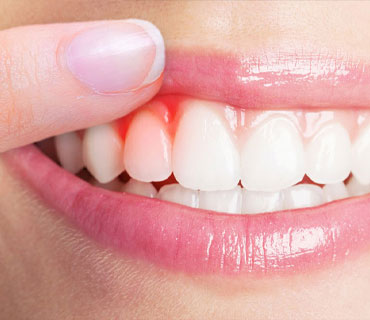Periodontics / Periodontist
Our mouth is full of bacteria. In fact, our teeth are constantly being coated with a white layer(film) of debris and bacteria. This layer is called plaque. In a healthy mouth there is a natural balance of different bacteria. You can never completely get rid of all the bacteria in your mouth, but brushing and flossing help reduce the bacteria by removing plaque. If plaque is not removed over time, it will harden to form calculus( tartar). Thin calculus must then be removed by a Dentist. Periodontal disease is more commonly known as gum disease and was referred to as pyorrhea in the old days.
It is a progressive inflammatory disease of the gingival and the surrounding tissue (bone) around the teeth. Periodontal disease is the number one cause of tooth loss after the age of 30 and it is believed that around 80% of the population above the age of 30 may suffer from this disease, with varying degrees of severity. It is usually painless and is mainly caused by plaque although pregnancy, diabetes, epilepsy, and such medications as chemotherapy, medication prescribed for heart problems, birth control pills, and antidepressants can all make you more susceptible to gingivitis which is one of the more common forms of periodontal disease.
Looking for Gum treatment in Gurgaon? Dr Goel Dental Clinic having best periodontics in Gurgaon that specialized in bleeding gum treatment.

How does Periodontal/ Gum disease develop?
- Poor oral hygiene: The root cause of gum disease is plaque.
- Diet: Nutritional deficiencies (e.g.vit.C deficiency), excessive alcohol consumption.
- Habits: smoking, pan chewing, tobacco chewing, excessive use of toothpicks.
- Dental Cause: Large un attentended cavities, irregular teeth, ill fitting dentures, ongoing braces treatment.
- Medical Causes: Diabetes, pregnancy, use of oral contraceptives, steroids, etc.
- BAD BREATH
- RED OR SWOLLEN GUMS
- LOOSE TEETH
- SENSITIVE TEETH
- PUS COMING FROM AROUND THE TEETH
- PAIN ON CHEWING
- TENDER GUMS
- BLEEDING GUMS
- SUDDEN APPEARANCE OF SPACES BETWEEN TEETH
Professional clean up / oral prophylaxis / scaling and polishing is essential at least once every six months for all individuals in order to maintain the overall health of the oral cavity. It involves the removal of plaque, tartar and stains which accumulate over a period of time. Early symptoms of gum disease include gum bleeding without pain. Pain is a symptom of more advanced gum disease as the loss of bone around the teeth leads to the formation of gum pockets. Bacteria in these pockets cause gum infection, swelling, pain, and further bone destruction. Advanced gum disease can cause loss of otherwise healthy teeth.
Treatment of periodontal disease depends on how much damage the disease has caused. Since periodontitis affects more than just the gums, it cannot be controlled with regular brushing and flossing. Treatment of periodontal disease is often extensive. The primary goals of all professional treatment are to promote reattachment of healthy gums to teeth, to reduce swelling, the depth of pockets, and the risk of infection, and stop further damage. Treatment options may be non surgical or surgical.
SCALING AND ROOT PLANNING
Scaling:This is a type of cleaning . It removes plaque and tartar from the teeth and below the gum line.
Root Planning: The Dentist smoothens the root surface so that supportive tissues can reattach to the tooth surface. Local anesthesia may be used, as this procedure goes deeper than regular cleaning. Your Dentist may remove a small amount of infected gum tissue with a procedure called soft tissue curettage.
- Antibiotics and Anti inflammatory medicines.
- Bite Correction.
- Splinting [using adjacent strong teeth to support the weak or mobile teeth]. Consult your Dentist for more information on specific procedures.
In later stage of the disease, depending on the severity, and of the following procedures may be indicated.
-
Gingivectomy :This procedure removes and overgrowth of gum tissue taking the gum level back to it's original positions.
-
Flap Surgery :During this procedures an incision is made, a "flap" is lifted. The gums are gently separated from the tooth. Creating an access to the infected pocket. Deep deposits of plaque are then removed.
The gums is then replaced on the tooth near the original gum line. -
Reshaping :The Bone Your Dentist may perform osseous (bone) surgery to shape the bone after the flap surgery. The gums are sutured below the original gum line to reduce areas that trap plaque.
Only professional treatment is not a cure for gum disease; it wants your dedication too. do these simple tips as part of a self care
- Brush your teeth two times a day.
- Floss regularly between the teeth.
- Rinse your mouth thoroughly after each meal and if possible try brushing.
- Replace your brush every 3 months.
